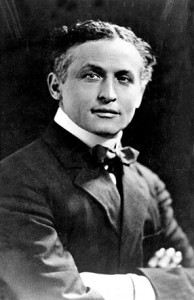Harry Houdini was born Erik Weisz on this day in 1874 in Budapest, then part of Austria-Hungary, to Rabbi Mayer Sámuel Weisz and Cecília Weisz (née Steiner). He was one of seven children, and in 1878, he, four of his brothers, and his pregnant mother sailed to the United States (the rest of the family would follow within the next two years). It was at this point that the young man began using the more English-sounding “Harry”, and made his stage debut at the age of 9 as a trapeze artist. It wasn’t long before he was performing as a magician under the name “Harry Houdini”.
Though he began performing in 1891, it wasn’t until 1899 that he met manager Martin Beck, who became his agent and launched Houdini’s career as an escape artist with a worldwide tour. Houdini was assisted by his wife, Bess, who was herself a stage performer. They remained partners–on stage and off–for the rest of their lives.
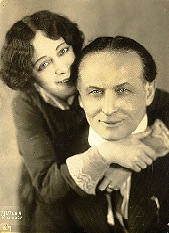
Houdini’s career is the stuff of legends. He escaped from handcuffs, including a pair fashioned at the expense of London’s Daily Mirror, which reportedly took five years to make. There are still suspicions amongst Houdini biographers at to whether this particular act was a stunt arranged by Houdini for publicity, and whether his wife, Bess, smuggled him the key after over an hour of work failed to free him.
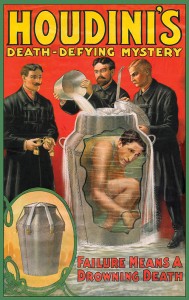 He escaped from a sealed milk crate (while handcuffed). When this trick became familiar, he had the milk crate locked in a waterproof box. When that became commonplace, he escaped from a Chinese “water torture box” into which he was locked upside down, with his feet in stocks. He actually copyrighted this trick so that he could sue people trying to duplicate it–and did. He escaped from a straightjacket suspended from the roof of an office building. He was thrown overboard, locked in a box. He was buried alive. And still, he escaped.
He escaped from a sealed milk crate (while handcuffed). When this trick became familiar, he had the milk crate locked in a waterproof box. When that became commonplace, he escaped from a Chinese “water torture box” into which he was locked upside down, with his feet in stocks. He actually copyrighted this trick so that he could sue people trying to duplicate it–and did. He escaped from a straightjacket suspended from the roof of an office building. He was thrown overboard, locked in a box. He was buried alive. And still, he escaped.
He was also briefly, a movie star, though, sadly, a good deal of the film featuring Houdini was destroyed (though his only full-length feature, The Grim Game, was finally restored by Turner Classic Movies last year). And, in all things, Houdini was a perfectionist. He planned his stunts, kept notes on their effect, and insisted on hard work and originality from those around him. As a result, he made it his life’s work to debunk those who were making “magic” at the expense of others.
Houdini famously debunked a number of other magicians and spiritualists who purported to communicate with the dead. He performed shows that demonstrated how people made tables tilt, or reproduced photographs to show how people might appear in a photo with Abraham Lincoln (as seen below). Were it not for a bizarre encounter and a medical emergency, he might have accomplished even more.
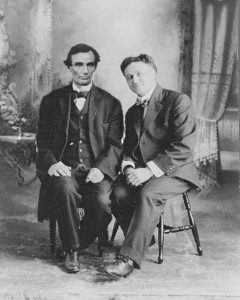
Many people have heard about J. Gordon Whitehead, the McGill University Student who, according to two fellow students who were with him at the time, asked Houdini “if he believed in the miracles of the Bible” and “whether it was true that punches in the stomach did not hurt him”, before repeatedly punching him in the stomach, below this belt. A note: this is not a nice thing to do. Not surprisingly, Houdini remained in enormous pain throughout the night and into the next day. It was only then discovered that he had a fever of 102 degrees, which continued to climb over the next few days. He was admitted Detroit’s Grace Hospital after passing out during a performance on October 26, 1926, with acute appendicitis and a fever of 104 degrees. Now, there is no direct correlation between stomach trauma (like those punches) and appendicitis, but doctors today are confident that the pain of the punches could have masked the symptoms of appendicitis. It was also enough for Houdini’s insurance company to pay a double indemnity for his death as a work-related accident.
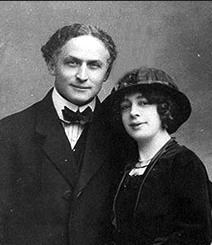 Houdini and his wife devised a secret code, so that, in case it were possible to communicate with the dead, he would be able to speak to her. Their code was “Rosabelle Believe”, inspired by their favorite song, ‘Rosabelle”. For ten years, after Houdini’s death on Halloween, 1926, Bess held a seance to try and talk again with her husband. Though she herself was nearly taken in by several mediums, she never did get to speak with her husband. In 1936, following another unsuccessful seance on the roof of the Knickerbocker Hotel, she went home and blew out the candle she had kept lit for a decade next to the photo of Houdini. Years later, she explained “ten years is long enough to wait for any man.” She would pass away in 1971–and one can only hope that they finally got the chance to chat again.
Houdini and his wife devised a secret code, so that, in case it were possible to communicate with the dead, he would be able to speak to her. Their code was “Rosabelle Believe”, inspired by their favorite song, ‘Rosabelle”. For ten years, after Houdini’s death on Halloween, 1926, Bess held a seance to try and talk again with her husband. Though she herself was nearly taken in by several mediums, she never did get to speak with her husband. In 1936, following another unsuccessful seance on the roof of the Knickerbocker Hotel, she went home and blew out the candle she had kept lit for a decade next to the photo of Houdini. Years later, she explained “ten years is long enough to wait for any man.” She would pass away in 1971–and one can only hope that they finally got the chance to chat again.
If you’re looking for more information on Houdini, or books inspired by him, check out these today!
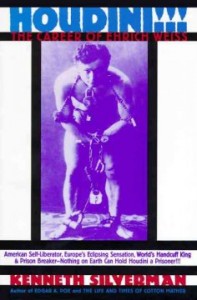 Houdini! : The Career of Ehrich Weiss: Kenneth Silverman’s work is considered by many scholars to be one of the best biographies on Houdini available. By drawing on private papers and diaries, court cases, unpublished notes and letters, Silverman very carefully parses the legends that have sprung up around Houdini, and distinguishes between the man and the myth he helped to create. Best of all, it’s a highly readable book that captures not only Houdini, but the wonderfully vivid, fascinating world in which he lived.
Houdini! : The Career of Ehrich Weiss: Kenneth Silverman’s work is considered by many scholars to be one of the best biographies on Houdini available. By drawing on private papers and diaries, court cases, unpublished notes and letters, Silverman very carefully parses the legends that have sprung up around Houdini, and distinguishes between the man and the myth he helped to create. Best of all, it’s a highly readable book that captures not only Houdini, but the wonderfully vivid, fascinating world in which he lived.
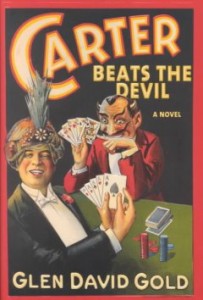 Carter Beats the Devil: I think I’ve already noted that this is one of my favorite books of all times, but for those looking for a great story about vaudeville entertainment and the heyday of stage magicians need look no further. Charles Carter was himself a magician, whose show featuring him defeating the Devil in a card game–but this story goes beyond his actual bio to tell a beautiful, heartbreaking, and constantly surprising story about love, life, and redemption. Houdini himself makes a cameo in this story, helping launch Carter’s career, and author Glen David Gold does the great man much credit in his interpretation.
Carter Beats the Devil: I think I’ve already noted that this is one of my favorite books of all times, but for those looking for a great story about vaudeville entertainment and the heyday of stage magicians need look no further. Charles Carter was himself a magician, whose show featuring him defeating the Devil in a card game–but this story goes beyond his actual bio to tell a beautiful, heartbreaking, and constantly surprising story about love, life, and redemption. Houdini himself makes a cameo in this story, helping launch Carter’s career, and author Glen David Gold does the great man much credit in his interpretation.
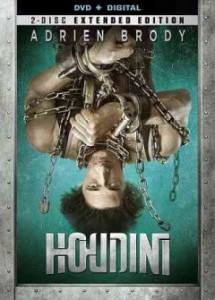 Houdini: This most recent biopic of Houdini stars Adrien Brody as the man himself. A bit sensationalized? Quite probably. Is Brody’s hair a bit…much? Yes, certainly, But this is one slick, stylish films that does its best to tell an accurate story, and does so in a way that is, ahem, spellbinding fun.
Houdini: This most recent biopic of Houdini stars Adrien Brody as the man himself. A bit sensationalized? Quite probably. Is Brody’s hair a bit…much? Yes, certainly, But this is one slick, stylish films that does its best to tell an accurate story, and does so in a way that is, ahem, spellbinding fun.

